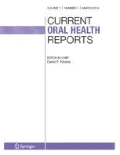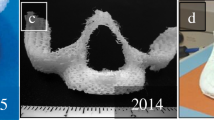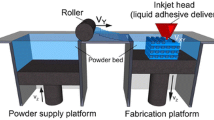Abstract
Three dimensional printing, or additive manufacturing, allows the production of customized scaffolds that can enhance craniofacial reconstruction and regeneration. It can be achieved by several techniques, including selective laser sintering, electron beam melting, fused deposition melting, fused filament fabrication, as well as extrusion and laser-assisted bioprinting of cells. 3D-printed constructs can take the form of nonresorbable solid form prosthesis or porous degradable scaffolds that can be resorbed over time and replaced by native tissues. The later can be considered the more desirable outcome but it is also more challenging to achieve. 3D-printed constructs have been used in a variety of oro-dental and craniofacial applications, including vertical bone augmentation, mandibular, and skull defect reconstruction, periodontal regeneration, and temporomandibular joint replacement. Although considerable advancements have been made, challenges remain in translating this technology to the clinic, especially in producing customized, porous, and inter-connected scaffolds for the regeneration of complex multiphasic tissues of varying dimensions ranging from a few millimeters to several centimeters.

Similar content being viewed by others
References
Papers of particular interest, published recently, have been highlighted as: • Of importance •• Of major importance
ASTM-International. Standard Terminology for Additive Manufacturing – General principles – Terminology. West Conshohocken, PA: ASTM International; 2015.
Hutmacher DW, Schantz T, Zein I, Ng KW, Teoh SH, Tan KC. Mechanical properties and cell cultural response of polycaprolactone scaffolds designed and fabricated via fused deposition modeling. J Biomed Mater Res. 2001;55:203–16. This foundation paper established 3D printing as a potent manufacturing tool for regenerative medicine and tissue engineering.
Hollister S. Porous scaffold design for tissue engineering. Nat Mater. 2005;4:518–24. This paper described the CAD/CAM approach for manufacturing porous patient specific 3D-scaffolds utilized in various tissue engineering applications.
Hutmacher DW. Scaffolds in tissue engineering bone and cartilage. Biomaterials. 2000;21:2529–43.
Schek RM, Taboas JM, Segvich SJ, Hollister SJ, Krebsbach PH. Engineered osteochondral grafts using biphasic composite solid free-form fabricated scaffolds. Tissue Eng. 2004;10:1376–85.
Williams JM, Adewunmi A, Schek RM, Flanagan CL, Krebsbach PH, Feinberg SE, et al. Bone tissue engineering using polycaprolactone scaffolds fabricated via selective laser sintering. Biomaterials. 2005;26:4817–27.
Murr LE, Gaytan SM, Ramirez DA, Martinez E, Hernandez J, Amato KN, et al. Metal fabrication by additive manufacturing using laser and electron beam melting technologies. Journal of Materials Science andTechnology. 2012;28:1–14.
Crump SS. Apparatus and method for creating three-dimensional objects. US Patent No. 5121329. 1992.
Mironov V, Boland T, Trusk T, Forgacs G, Markwald RR. Organ printing: computer-aided jet-based 3D tissue engineering. Trends Biotechnol. 2003;21:157–61.
Bertassoni LE, Cardoso JC, Manoharan V, Cristino AL, Bhise NS, Araujo WA, et al. Direct-write bioprinting of cell-laden methacrylated gelatin hydrogels. Biofabrication. 2014;6:024105.
Yeo MG, Lee J-S, Chun W, Kim GH. An innovative collagen-based cell-printing method for obtaining human adipose stem cell-laden structures consisting of core-sheath structures for tissue engineering. Biomacromolecules. 2016;17:1365–75.
Hinton TJ, Jallerat Q, Palchesko RN, Park JH, Grodzicki MS, Shue H-J, et al. Three-dimensional printing of complex biological structures by freeform reversible embedding of suspended hydrogels. Science Advances 2015;1:1500758.
Tabriz AG, Hermida MA, Leslie NR, Shu W. Three-dimensional bioprinting of complex cell laden alginate hydrogel structures. Biofabrication. 2015;7:045012.
Melchels FPW, Dhert WJA, Hutmacher DW, Malda J. Development and characterisation of a new bioink for additive tissue manufacturing. J Mater Chem B. 2014;2:2282–9. This paper demonstrated in an elegant manner that the bio-ink rheological properties can be tailored to achieve high shape fidelity during 3D-printing.
Barron JA, Wu P, Ladouceur HD, Ringeisen BR. Biological laser printing: a novel technique for creating heterogeneous 3-dimensional cell patterns. Biomed Microdevices. 2004;6:139–47.
Guillotin B, Guillemot F. Cell patterning technologies for organotypic tissue fabrication. Trends Biotechnol. 2011;29:183–90.
Guillemot F, Souquet A, Catros S, Guillotin B. Laser-assisted cell printing: principle, physical parameters versus cell fate and perspectives in tissue engineering. Nanomedicine. 2010;5:507–15.
Ali M, Pages E, Ducom A, Fontaine A, Guillemot F. Controlling laser-induced jet formation for bioprinting mesenchymal stem cells with high viability and high resolution. Biofabrication. 2014.
Guillotin B, Souquet A, Catros S, Duocastella M, Pippenger B, Bellance S, et al. Laser assisted bioprinting of engineered tissue with high cell density and microscale organization. Biomaterials. 2010;31:7250–6.
Keriquel V, Guillemot F, Arnault I, Guillotin B, Miraux S, Amédée J, et al. vivo bioprinting for computer- and robotic-assisted medical intervention: preliminary study in mice. Biofabrication. 2010;2:014101.
Tamimi F, Torres J, Gbureck U, Lopez-Cabarcos E, Bassett DC, Alkhraisat MH, et al. Craniofacial vertical bone augmentation: a comparison between 3D printed monolithic monetite blocks and autologous onlay grafts in the rabbit. Biomaterials. 2009;30:6318–26.
Tamimi F, Torres J, Al-Abedalla K, Lopez-Cabarcos E, Alkhraisat MH, Bassett DC, et al. Osseointegration of dental implants in 3D-printed synthetic onlay grafts customized according to bone metabolic activity in recipient site. Biomaterials. 2014;35:5436–45.
Moussa M, Carrel JP, Scherrer S, Cattani-Lorente M, Wiskott A, Durual S. Medium-term function of a 3D printed TCP/HA structure as a new osteoconductive scaffold for vertical bone augmentation: a simulation by BMP-2 activation. Materials. 2015;8:2174–90.
Carrel J-P, Wiskott A, Moussa M, Rieder P, Scherrer S, Durual S. A 3D printed TCP/HA structure as a new osteoconductive scaffold for vertical bone augmentation. Clin Oral Impl Res. 2016;27:55–62. This study demonstrated that porous ceramic 3D-printed scaffold can stimulate vertical bone in growths in a large animal model.
Carrel JP, Wiskott A, Scherrer S, Durual S. Large bone vertical augmentation using a three-dimensional printed TCP/HA bone graft: a pilot study in dog mandible. Clin Implant Dent Relat Res. 2016; in press.
Suska F, Kjeller G, Tarnow P, Hryha E, Nyborg L, Snis A, et al. Electron beam melting manufacturing technology for individually manufactured jaw prosthesis: a case report. J Oral Maxillofac Surg. 2015;74(1706):e1–e15.
Klammert U, Gbureck U, Vorndran E, Rödiger J, Meyer-Marcotty P, Kübler AC. 3D powder printed calcium phosphate implants for reconstruction of cranial and maxillofacial defects. J Cranio-Maxillofac Surg. 2010;38:565–70.
Jardini AL, Larosa MA, Filho RM, Zavaglia CADC, Bernardes LF, Lambert CS, et al. Cranial reconstruction: 3D biomodel and custom-built implant created using additive manufacturing. J Cranio-Maxillofac Surg. 2014;42:1877–84.
Fiaschi P, Pavanello M, Imperato A, Dallolio V, Accogli A, Oapra V, et al. Surgical results of cranioplasty with a polymethylmethacrylate customized cranial implant in pediatric patients: a single-center experience. Journal of neurosurgery Pediatrics. 2016;17:705–10.
Rammos CK, Cayci C, Castro-Garcia JA, Feiz-Erfan I, Lettieri SC. Patient-specific polyetheretherketone implants for repair of craniofacial defects. The Journal of craniofacial surgery. 2015;26:631–3.
Park E-K, Lim J-Y, Yun I-S, Kim J-S, Woo S-H, Kim D-S, et al. Cranioplasty enhanced by three-dimensional printing: custom-made three-dimensional-printed titanium implants for skull defects. J Craniofac Surg. 2016;27:943–9.
Shim JH, Yoon MC, Jeong CM, Jang J, Jeong SI, Cho DW, et al. Efficacy of rhBMP-2 loaded PCL/PLGA/β-TCP guided bone regeneration membrane fabricated by 3D printing technology for reconstruction of calvaria defects in rabbit. Biomedical Materials (Bristol). 2014;9.
Probst FA, Hutmacher DW, Muller DF, Machens HG, Calvarial TSJ. Reconstruction by customized bioactive implant. Handchir Mikrochir Plast Chir. 2010;42:369–73. This paper is the first clinical trial which utilized a patient specific additively manufactured scaffold for treating large skull defect.
Hutmacher DW, Lauer G. Grundlagen and aktuelle Anwendungen des Tissue Engineering in der Mund-. Kiefer und Gesichtschirurgie Implantologie. 2003;143-56.
Ivanovski S, Vaquette C, Gronthos S, Hutmacher DW, Bartold PM. Multiphasic scaffolds for periodontal tissue engineering. J Dent Res. 2014;93:1212–21.
Vaquette C, Fan W, Xiao Y, Hamlet S, Hutmacher DW, Ivanovski SA. Biphasic scaffold design combined with cell sheet technology for simultaneous regeneration of alveolar bone/periodontal ligament complex. Biomaterials. 2012;33:5560–73.
Costa PF, Vaquette C, Zhang Q, Reis RL, Ivanovski S, Hutmacher DW. Advanced tissue engineering scaffold design for regeneration of the complex hierarchical periodontal structure. J Clin Periodontol. 2014;41:283–94.
Park CH, Rios HF, Jin Q, Bland ME, Flanagan CL, Hollister SJ, et al. Biomimetic hybrid scaffolds for engineering human tooth-ligament interfaces. Biomaterials. 2010;33:137–45.
Park CH, Rios HF, Jin Q, Sugai JV, Padial-Molina M, Taut AD, et al. Tissue engineering bone-ligament complexes using fiber-guiding scaffolds. Biomaterials. 2012;33:137–45.
Pilipchuk SP, Monje A, Jiao Y, Hao J, Kruger L, Flanagan CL, et al. Integration of 3D printed and micropatterned polycaprolactone scaffolds for guidance of oriented collagenous tissue formation in vivo. Advanced Healthcare Materials. 2016;5:676–87.
Lee CH, Hajibandeh J, Suzuki T, Fan A, Shang P, Mao JJ. Three-dimensional printed multiphase scaffolds for regeneration of periodontium complex. Tissue Eng A. 2014;20:1342–51.
Rasperini G, Pilipchuk SP, Flanagan CL, Park CH, Pagni G, Hollister SJ, et al. 3D-printed bioresorbable scaffold for periodontal repair. J Dent Res. 2015;94:153S–7S. In this case report, a 3D-printed patient specific scaffold was implanted to treat a periodontal lesion.
Hollister SJ, Lin CY, Saito E, Lin CY, Schek RD, Taboas JM, et al. Engineering craniofacial scaffolds. Orthod Craniofacial Res. 2005;8:162–73.
Smith MH, Flanagan CL, Kemppainen JM, Sack JA, Chung H, Das S, et al. Computed tomography-based tissue-engineered scaffolds in craniomaxillofacial surgery. Int J Med Robotics Comput Assist Surg. 2007;3:207–16.
Legemate K, Tarafder S, Jun Y, Lee CH, Engineering Human TMJ. Discs with protein-releasing 3D-printed scaffolds. J Dent Res. 2016;95:800–7.
Author information
Authors and Affiliations
Corresponding author
Ethics declarations
Conflict of Interest
Peter Mark Bartold and Saso Ivanovski declare that they have no conflict of interest.
Cedryck Vaquette reports grants from QUT during the conduct of study.
Human and Animal Rights and Informed Consent
This article does not contain any studies with human or animal subjects performed by any of the authors.
Additional information
This article is part of the topical collection on Orodental Regenerative Medicine
Rights and permissions
About this article
Cite this article
Vaquette, C., Bartold, P.M. & Ivanovski, S. Current Developments in 3D Printing for Craniofacial Regeneration. Curr Oral Health Rep 3, 319–327 (2016). https://doi.org/10.1007/s40496-016-0114-y
Published:
Issue Date:
DOI: https://doi.org/10.1007/s40496-016-0114-y




